How to Paint a Room: A Comprehensive Guide
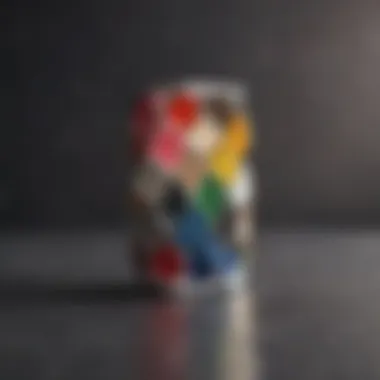
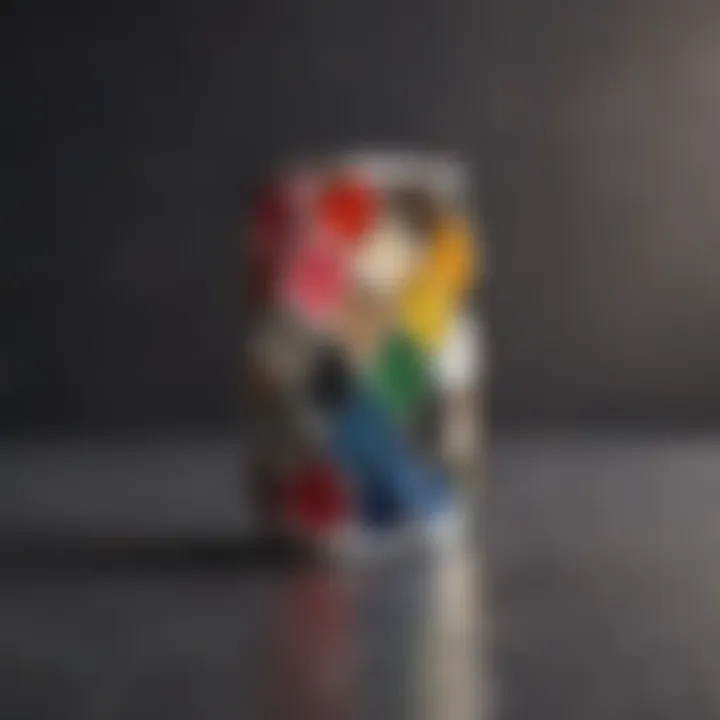
Intro
Painting a room is more than just a task; it is an opportunity to express one’s style and transform a living space. This guide aims to provide a thorough exploration of the steps necessary to paint a room effectively, ensuring each homeowner can navigate the painting process with confidence.
Understanding the importance of preparation, choosing the right materials, colors, and techniques can make a significant impact on the final look of a room. The satisfaction derived from completing a painting project successfully is immense and can elevate the aesthetics of any interior.
Interior Design Tips
Painting a room often serves as a pivotal moment in interior design. It’s essential to consider how paint interacts with furniture, lighting, and overall room layout. Below are some insightful ideas to enhance your design experience.
Trendy Design Ideas
Current trends lean towards creating spaces that reflect personal style. Using bold colors can create focal points, while softer shades provide a soothing atmosphere. Two-tone walls, where one color forms a base and another highlights architectural features, are becoming increasingly popular.
Here are a few ideas to keep in mind:
- Accent Walls: Choose a vibrant color or patterned wallpaper for one wall to draw attention.
- Matte Finishes: These can add a modern touch compared to traditional glossy paints.
- Combining Textures: Using paint with different finishes can create visual interest in a space.
Color Schemes and Combinations
Selecting the right colors is crucial for achieving the desired ambiance. Colors often evoke emotions and set the mood of a room. Popular schemes include monochromatic, complementary, and triadic combinations.
When considering colors, it’s helpful to follow these suggestions:
- Warm Colors: Reds, yellows, and oranges create an energetic and inviting space.
- Cool Colors: Blues, greens, and purples are calming and ideal for bedrooms.
- Neutral Colors: Whites, grays, and beiges provide a versatile backdrop for decor.
Furniture Arrangement Techniques
The way furniture is arranged can drastically influence how a room feels. After painting, take the opportunity to reassess the layout. Ensuring a good flow involves rearranging furniture for optimal accessibility. Here are some techniques:
- Focal Point Alignment: Position furniture around a focal point, like a fireplace or window view.
- Floating Furniture Placement: Place pieces away from walls to create an open space feel.
- Proper Spacing: Leave enough space between furniture to allow easy movement.
"The impact of color on atmosphere cannot be overstated. A well-thought-out palette changes not just the aesthetic, but the emotional experience of a room."
In sum, these interior design tips present a substantial foundation for creating a beautiful room through paint. By embracing modern trends and thoughtful arrangements, one can achieve a harmonious and inviting atmosphere.
Prologue to Room Painting
Painting a room is more than just applying color to walls; it is a process that transforms a space and impacts the aesthetic and emotional experience of those who occupy it. The significance of room painting lies in its ability to revitalize interior environments, making them welcoming and visually appealing. This article will guide readers through the essential steps of painting a room, discussing preparation, selecting materials, and efficiently executing the painting process.
The act of painting brings forth a number of benefits. Firstly, it can increase the value of a home. A well-executed paint job can attract potential buyers and elevate the overall perception of the property. Secondly, paint can influence mood. Colors can evoke feelings of calmness, energy, or creativity, depending on how they are used. Therefore, understanding color psychology is crucial for creating the desired atmosphere.
Moreover, careful consideration is necessary when preparing for a paint project. This phase often determines the quality of the final result. Factors such as choosing the right time, selecting appropriate paint and tools, and protecting existing furniture all play an important role in the effectiveness of painting. The article will delve deeper into these considerations, ensuring a comprehensive understanding of the initial stages before painting begins.
In summary, room painting is a multifaceted endeavor that requires strategic planning and execution. By highlighting the fundamental components which should be considered in this extensive guide, readers will be better equipped to undertake their painting projects with confidence and skill.
Preparing the Room
Before embarking on the transformative journey of painting a room, it is essential to prepare adequately. Preparation sets the foundation for a successful paint job. This phase involves not only creating a suitable environment for painting but also ensuring that the end result is visually satisfying and durable.
One of the primary benefits of thorough preparation is minimizing potential issues during the actual painting process. By addressing various factors prior to painting, you reduce the likelihood of mistakes, uneven application, and the need for extensive touch-ups later.
Additionally, careful preparation can significantly improve the paint’s adhesion to surfaces. Paint can only look its best when applied to clean and well-prepared walls. Thus, investing time in preparation is crucial to achieving a professional-looking finish.
Clearing the Space
Clearing the space is the first step in preparing to paint a room. This involves removing any furniture, decor, and appliances that may obstruct the painting area. Not only does this make the painting process easier, but it also protects your belongings from potential paint splatters.
Start by moving larger items out of the room or to the center and covering them with drop cloths. Remember, clearing space is not just about moving items; it’s about creating a comfortable working area that allows unrestricted movement and reduces the risk of accidents. This can also prevent paint drips from settling on surfaces that are difficult to clean or repaint.
Protecting Furniture and Floors
Once you have cleared the room, the next critical step is protecting your furniture and flooring. Even with the utmost care, paint can find its way onto unintended surfaces. To prevent this, it’s wise to invest in high-quality drop cloths or plastic sheeting.
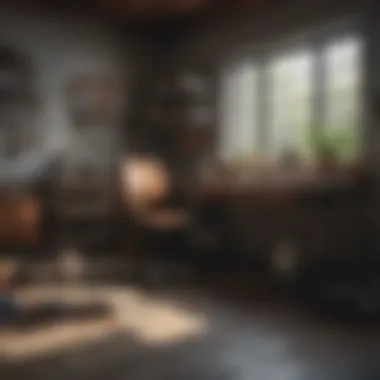
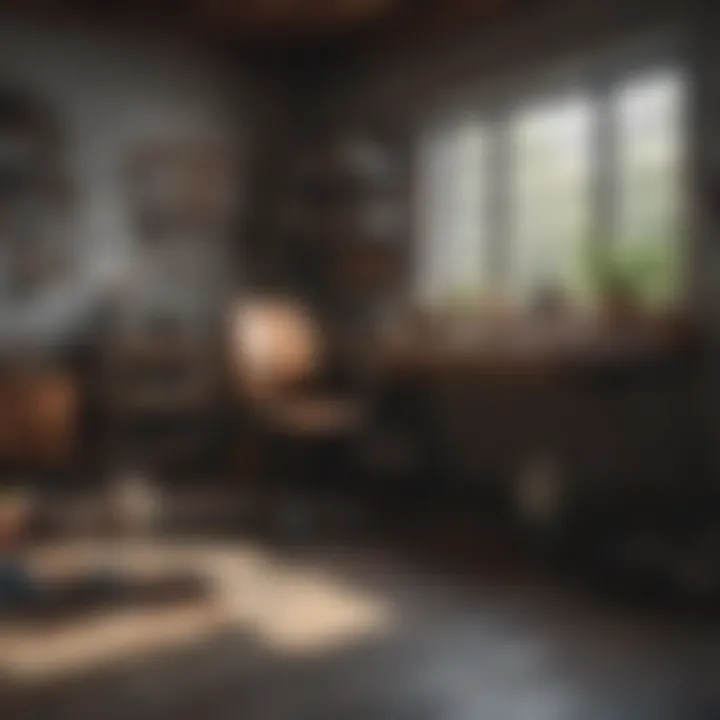
For floors, consider using heavy-duty plastic sheeting. This will catch any paint that may drip or spill. Ensure that the drop cloths lay flat on the floor, preventing any tripping hazards. If the furniture remains in the room, cover it securely with drop cloths as well. This step may seem tedious, but it is greatly beneficial and saves time in cleanup.
Choosing the Right Time
Timing your painting project can also affect the overall experience and results. Choose a time of year when weather conditions are favorable for drying paint. Ideally, you want to paint when humidity is low and temperatures are moderate. Extreme temperatures can affect drying time and the way paint adheres to surfaces.
Consider your schedule too. Set aside a few days for the project to ensure that you are not rushed. This allows for adequate drying time between coats and lets you work at a comfortable pace. It is wise to check the weather forecast to confirm that rain is not expected, as this can lead to increased humidity levels, causing problems for drying paint.
In summation, preparing the room is a critical stage for anyone planning to paint. From clearing the space, protecting valuables, to choosing the most appropriate time, each element plays a vital role in achieving a clean and lasting finish.
Selecting Paint and Supplies
Selecting the right paint and supplies is crucial in the painting process. The quality of your materials can significantly affect the outcome of your project. Understanding different types of paint, their finishes, and the proper tools to use allows for better planning and execution. This section will delve into selecting paint and supplies in detail, highlighting key aspects to consider and the benefits of making informed choices.
Understanding Different Types of Paint
Paint comes in various formulations, each with its own properties and intended uses. The major types include latex, oil-based, and acrylic paints.
- Latex Paint: This water-based option is user-friendly and easy to clean up, making it a popular choice among homeowners. It dries quickly and has low levels of volatile organic compounds (VOCs), which improves indoor air quality. Additionally, latex paint comes in a variety of colors and finishes.
- Oil-Based Paint: Known for its durability, oil-based paint is often used for high-traffic areas or surfaces that require a hard finish. However, it takes longer to dry and has a strong odor. Clean-up requires solvents like mineral spirits, which can be cumbersome.
- Acrylic Paint: This is a subset of latex paint, primarily used for its flexibility and vibrant coloration. It's suitable for both interior and exterior use, adhering well to various surfaces.
When choosing paint, consider the room’s specific needs, such as moisture levels and durability requirements.
Choosing the Right Finish
The finish of the paint refers to its sheen and reflectiveness. Each finish serves a unique purpose and may suit different areas of your home:
- Flat or Matte Finish: These have no shine and work well for walls in low-traffic areas, offering a modern look while hiding imperfections.
- Eggshell Finish: A step up from flat, eggshell finishes are easier to clean and are suitable for most rooms, including living areas and bedrooms.
- Satin Finish: This finish has a soft sheen and is great for kitchens and children's rooms due to its washability and durability.
- Semi-Gloss Finish: Highly reflective, semi-gloss is ideal for moldings and trim, as it can withstand cleaning and moisture.
- Gloss Finish: This is the most reflective and durable option, suitable for areas that require a robust surface, such as cabinets.
Consider the room’s purpose when selecting a finish. Choosing the right finish enhances aesthetics and facilitates maintenance.
Essential Tools for Painting
Having the right tools at your disposal can make the difference between a tedious task and a seamless experience. Here are the must-have tools for your painting project:
Rollers
Rollers are widely used for painting large surfaces, like walls and ceilings, as they cover more area in less time compared to brushes. The key characteristic of rollers is their ability to provide a smooth finish while minimizing brush strokes.
The unique feature of rollers is their variety of nap lengths, which allow you to choose the thickness based on the surface texture. A short nap is suitable for smooth surfaces, while a longer nap provides better coverage for textured ones. However, one disadvantage is that they may require a bit of practice to control.
Brushes
Brushes are essential for detailed work and precise application, such as painting edges, corners, and trim. The key characteristic of brushes is their diverse shapes and sizes, allowing for versatility in technique and control.
The unique feature of brushes is that they can reach tight spaces that rollers may miss. For instance, angle brushes can effectively navigate corners. A potential disadvantage is that using brushes can be labor-intensive and lead to visible brush marks if not used correctly.
Drop Cloths
Using drop cloths is a simple yet effective way to protect floors and furniture from paint splatters. The key characteristic of drop cloths is their capability to absorb paint, preventing stains and providing a cleaner workspace.
The unique feature of drop cloths is their availability in various materials, such as canvas or plastic. Canvas is reusable and durable, whereas plastic offers better waterproofing. However, they can sometimes be inconvenient to manage if they shift while working.
Calculating Paint Quantity
Calculating the right amount of paint ensures you do not buy excess or run out in the middle of a project. To determine the quantity, first, measure the perimeter of the room and the height of the walls. Multiply these dimensions to find the total square footage.
Next, subtract the area of doors and windows from the total. Most paint cans indicate the coverage, typically around 350 to 400 square feet per gallon. Therefore, dividing the adjusted wall area by this coverage value will provide the number of gallons needed. It’s wise to buy a little extra for touch-ups later, ensuring that you have consistency in color and finish.
Color Selection
Choosing the right colors for a room is a critical aspect of the painting process. Color selection influences not only the aesthetics of the space but also can affect moods and perceptions. Every color has psychological implications. Thus, understanding color psychology is essential. This section provides insight into how to choose colors that will enhance your home environment and reflect your personal style.
Understanding Color Psychology
Color psychology explores how different colors evoke feelings and responses. For instance, blue is known to promote calmness and tranquility, making it suitable for bedrooms. In contrast, yellow can bring energy and happiness, ideal for kitchens or playrooms. It’s vital to consider how the colors you choose will impact the daily experience in that space.
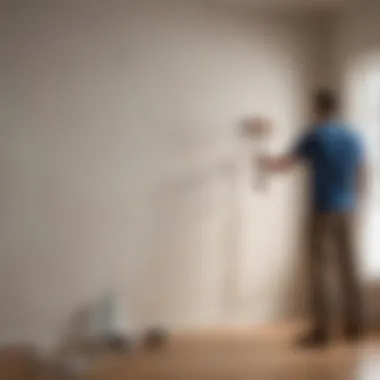
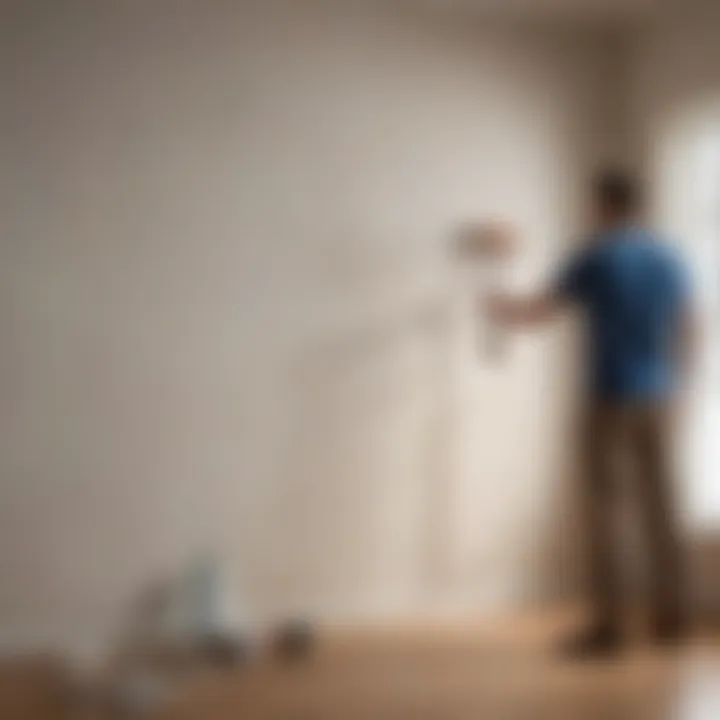
When selecting a color, think about its relationship with light. Natural light can dramatically change how a color appears throughout the day. Soft colors may look washed out in bright sunlight, while darker shades might absorb light, creating a cozy feeling.
Benefits of Considering Color Psychology
- Mood Enhancement: The well-chosen color can uplift spirits or create a soothing atmosphere.
- Spatial Perception: Lighter shades can make a room feel larger, while darker hues can provide intimacy.
- Complimenting Furniture: Colors should complement existing furniture and decor to create a cohesive look.
Inspiration Sources for Color Schemes
Finding the right color scheme involves research and inspiration. Consider browsing through various sources to gather ideas.
- Nature: Plants, flowers, and landscapes can provide unexpected yet harmonious color combinations.
- Art: Paintings and photographs can inspire unique palettes based on their hues and tones.
- Interior Design Magazines: Publications often showcase the latest trends and classic combinations.
- Online Platforms: Websites such as Pinterest or Instagram offer a plethora of visual inspiration.
Using tools like color wheels can help visualize how colors interact. It is helpful to look for complementary colors, which are opposite each other on the wheel, or analogous colors, which are next to each other. These tools can be invaluable in the planning phase.
Testing Paint Samples
After narrowing down color choices, the next step is to test. Purchasing sample pots of paint enables you to apply patches on your walls. This allows you to see how colors look in your specific lighting conditions.
- Apply Samples Strategically: Choose areas that receive both natural and artificial light to see how the color changes throughout the day.
- Use a White Primer: This will help the true color shine without interference from the old paint beneath.
- Observe at Different Times: Monitor how the color looks in morning light versus evening light.
Key Takeaway: Testing paint samples is crucial. It ensures that the final choice meets expectations and looks good in various lighting settings.
Overall, color selection is not merely about aesthetics but involves a deeper understanding of emotional and environmental contexts. This careful consideration will lead to a successful painting project, achieving the desired ambience and function in the space.
The Painting Process
The painting process is a crucial component of transforming a room. It encompasses various stages, from preparing the walls to applying the paint correctly. Understanding this process allows homeowners and designers to achieve a professional finish. It ensures the longevity of the paint job while enhancing the overall aesthetic of the space.
In this section, we shall explore the detailed steps involved in the painting process, focusing on cleaning, repairing, priming, and the techniques of application. Each part plays a significant role in ensuring the applied paint adheres well and yields an appealing result.
Preparing the Walls
Cleaning
Cleaning the walls is a fundamental step that cannot be overlooked. This action removes dust, dirt, and grease that may have accumulated over time. A clean surface improves paint adhesion, which is vital for achieving even coverage. A major characteristic of cleaning is its effectiveness in preparing the surface. Neglecting this step can lead to compromised paint durability.
For cleaning, a solution of warm water mixed with mild detergent can suffice for most surfaces. Ensure to allow the walls to dry thoroughly before proceeding to the next stage. This unique feature of cleaning highlights its role as a foundation for subsequent painting processes.
Repairing
Repairing walls is often necessary before painting. Dents, cracks, and holes can detract from the final look. This aspect emphasizes the importance of addressing imperfections for an aesthetically pleasing result. The key characteristic of repairing is its transformative nature; it sets the stage for smooth paint application.
Use spackling paste for minor repairs and patching materials for larger damages. The unique feature of repairing is the ability to restore evenness to surfaces, which directly influences the overall appearance after painting. However, it requires time and effort to complete, which might be a disadvantage for those looking to paint quickly.
Priming
Priming is a critical stage that prepares the surface for paint application. A primer creates an ideal base, especially on porous surfaces or when changing colors. The distinctive feature of priming is its capability to improve paint adhesion while ensuring true color representation. This means you achieve the intended look without needing multiple coats of paint.
Priming also helps in blocking stains and preventing bleed-through. It is often considered a beneficial step in a painting project. However, some may see it as an additional chore, increasing the workload while also increasing overall project time.
Techniques for Application
Cutting In
Cutting in refers to the technique of painting edges and corners where a roller cannot reach. It involves using a brush to outline areas such as windows, doors, and ceilings. This step is essential to maintain clean lines and separation between different colors or finishes. The key characteristic of cutting in is its precision. It enables you to achieve sharp, professional-looking edges that elevate the quality of the work.
While cutting in can be a skill that takes practice, mastering it is a popular choice for many painters seeking a neater finish. The unique feature of cutting in is that it allows for control over the detailing around prominent edges. However, it may take extra time and focus, which might be perceived as a disadvantage by those in a hurry.
Rolling
Rolling is a widely used method for painting flat surfaces. This technique involves using a roller to apply paint quickly and uniformly. The key advantage of rolling is its efficiency in covering large areas without the streaking that brushes may leave behind. It is a common choice due to its speed, making it suitable for substantial wall spaces.
One of the challenges of rolling can be ensuring even pressure; otherwise, it may lead to an inconsistent finish. Yet, this method remains a cornerstone in a professional painting process due to its ability to deliver smooth coverage.
Using Brushes
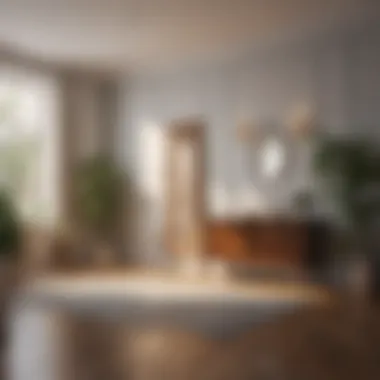
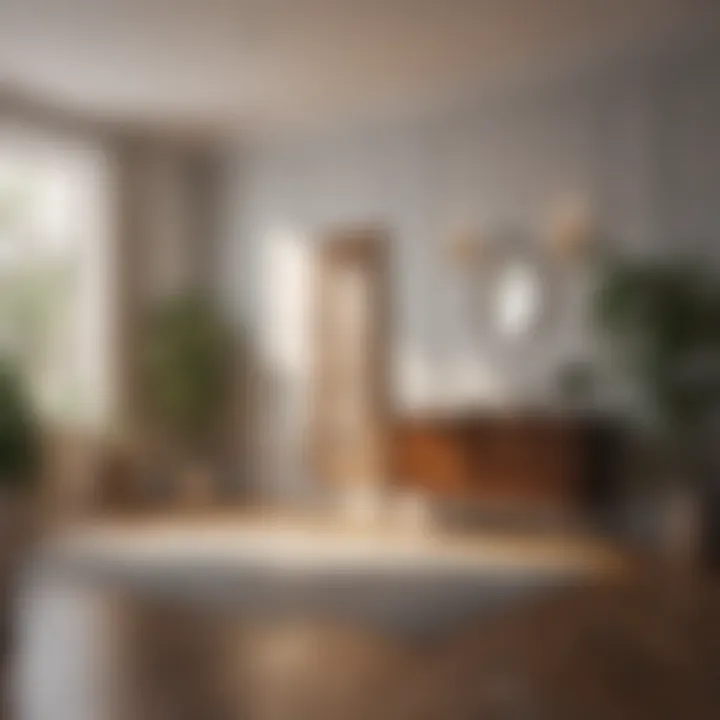
Using brushes is an essential part of the painting process, particularly for detailed work. Brushes allow for intricate designs and are ideal for smaller areas or textured surfaces. Their key characteristic is versatility, making them suitable for various paint types and textures.
While brushes can take longer to apply paint compared to rollers, they excel in providing fine detail and craftsmanship in finishing touches. Additionally, brushes can result in a more controlled application, allowing creativity to flourish in the design. However, they require more effort to clean compared to rollers, which can deter some from using them frequently.
Final Touches
Final touches are perhaps one of the most rewarding moments in the painting process. After completing all the painting steps, taking time to review the work ensures that no details are overlooked. This includes checking for missed spots, uneven areas, and overall finish quality. It allows for adjustments, ensuring a polished and complete appearance to the space. This attention to detail can elevate the overall project quality and provide satisfaction to the painter.
Post-Painting Considerations
Post-painting considerations are vital to ensure that the efforts put into a painting project yield lasting results. It is common to finish painting, feel satisfied, and ignore the aftermath. However, taking time to address the steps after the painting process is crucial for achieving an optimal finish. The right aftercare can enhance the overall look of the surface and extend the life of the paint job. Each consideration plays a unique role in that experience, benefiting the homeowner both aesthetically and practically.
Cleaning Up After Painting
Once the painting is complete, the first task is to clean up. This is more than just disposing of used materials. Properly cleaning brushes, rollers, and trays not only extends their lifespan but also prevents unwanted messes in future projects. Water-based paints can be cleaned using soap and water, but oil-based paints require mineral spirits for effective cleanup.
Additionally, removing painter's tape should be done with care. Pulling it off too quickly can cause the paint to peel or flake away. Instead, use a utility knife to gently score along the edges of the tape before pulling it away slowly. This will achieve a clean line, helping maintain the aesthetic of the freshly painted area.
"Cleaning up thoughtfully is as essential as the painting process itself. It preserves tools for future jobs and ensures a neat finish."
Inspecting for Imperfections
After cleaning up, it is important to inspect the painted surfaces for any imperfections. These may include uneven coverage, drips, or areas where the paint did not adhere properly. Identifying these details sooner rather than later allows for timely corrections.
When inspecting, look for:
- Color consistency
- Surface texture
- Edges and corners for unpainted spots
Using a bright light can help illuminate any flaws that need attention. Minor imperfections can be fixed with a small brush for touch-ups, while larger issues might necessitate repainting sections. Addressing these imperfections ensures that the room looks polished and well done.
Allowing Paint to Cure
Curing is a critical phase that follows the application of paint. Unlike drying, which occurs relatively quickly, curing involves the paint forming a solid bond with the surface. This process can take days or even weeks depending on various factors such as the type of paint, humidity, and temperature.
During this period, it is best to avoid heavy cleaning or placing items against the painted surface. It is also advisable to protect the area from moisture, as this can affect the curing process. Keeping the room well-ventilated is beneficial, as it helps the paint cure evenly. Simply following these guidelines turns a well-painted room into a lasting testament to your effort.
In summary, post-painting considerations are essential for maintaining the integrity and appearance of your paint job. By cleaning effectively, inspecting for imperfections, and allowing adequate curing time, the chances of achieving a professional look increase substantially. Such diligence will lead to a beautifully painted room that reflects the effort put into the project.
Maintaining Your Paint Job
Maintaining the integrity of your paint job is essential to ensure the long-lasting beauty and functionality of your painted surfaces. Regular maintenance not only preserves the aesthetics of your space but also enhances the durability of the paint. A well-maintained paint job is less susceptible to damage and fading. This section will explore various elements critical for maintaining your paint job effectively.
Tips for Long-Lasting Results
To maximize the longevity of your paint job, consider the following tips:
- Choose Quality Paint: Selecting high-quality paint significantly impacts durability. Look for brands known for their effectiveness, adhesion, and washability.
- Proper Surface Preparation: Ensure the surfaces are clean, dry, and smooth before painting. Proper preparation leads to better adhesion, reducing the likelihood of peeling and chipping.
- Repainting Schedule: Plan to repaint every five to seven years, or as needed based on wear and tear. Regular upkeep helps keep surfaces looking fresh.
- Use a Primer: Priming the wall before applying the paint can enhance coverage and prevent stains from showing through over time.
- Clean Surfaces Regularly: Dust and dirt can adhere to painted surfaces. Wipe surfaces lightly using a damp cloth to avoid buildup that can dull the paint.
Identifying and Fixing Damage
Even with the best maintenance practices, damage can occasionally occur. Here’s how to identify and address common issues:
- Inspect Regularly: Regular inspections can help catch imperfections early. Look for cracks, peeling, or discoloration. Areas that receive high traffic or exposure to moisture should be monitored closely.
- Repair Minor Scuffs: Use touch-up paint to fix minor scuffs and scratches. It is best to use leftover paint from the original job for seamless repairs.
- Address Mold and Mildew: In damp areas like bathrooms, mold and mildew can develop. If noticed, clean the area with a mold remover. After drying, repaint with a mold-resistant paint.
- Peeling and Blistering: For areas that have peeled or blistered, scrape off the damaged paint. Apply a primer to the exposed surface, then repaint to restore its appearance.
In summary, maintaining your paint job requires both proactive and reactive measures. By following these strategies, your painted surfaces can retain their charm and withstand the test of time. Regular upkeep not only enhances the aesthetic appeal of your home but also preserves the quality of your investment.
Ending
In the process of painting a room, the conclusion serves as a crucial component that ties together the entire journey. It is not merely an end point; rather, it encapsulates the reflections on the stages of preparation, execution, and post-painting care. The importance of this section lies significantly in emphasizing the cumulative benefits garnered from a careful and systematic approach.
First, a successful paint job enhances the aesthetic appeal of a space. When homeowners take the time to mindfully select colors and finishes, weigh techniques, and implement the right maintenance strategies, it results in a truly fulfilling transformation. Each brushstroke can reveal its potential not just visually, but also in creating an ambiance that aligns with personal preferences.
Moreover, understanding the nuances behind the painting process encourages a more mindful selection of supplies. Choosing quality paints, primers, and tools directly translates to the longevity of the finish. Therefore, in reflecting on this entire painting experience, one acknowledges that the right choices made at the beginning can pay off significantly down the line.
Consideration for maintenance post-painting creates a sense of responsibility and ownership. After investing time and effort into transforming a space, it is imperative to understand how to preserve and protect that investment. Knowing how to identify damage, perform minor repairs, and implement cleaning practices will ensure that the newly painted surfaces remain vibrant and inviting for years to come.
Lastly, a well-rounded conclusion consolidates the knowledge shared, allowing readers to fully grasp the essence of each phase in painting a room. The insights provided aim not just to equip individuals with tactics, but to inspire confidence in tackling the art of painting. It reinforces that every detail matters, from preparation to that final touch, as they all contribute to the overall success.
"A paint job done well reflects not only physical efforts but also the creativity and thoughtfulness inherent in every homeowner."
In summary, the conclusion of this guide initiates reflections on the entire painting procedure, emphasizing the significant aspects that lead to a successful transformation. It reassures readers that with proper planning and execution, they can achieve stunning results, fostering personal enjoyment in their spaces.







